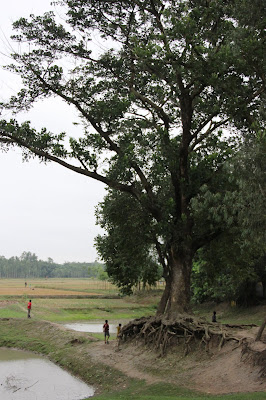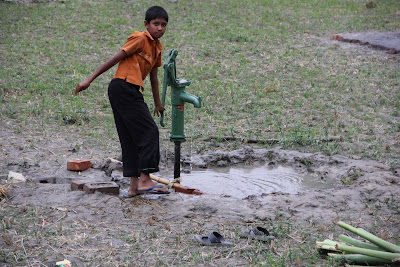After a rather long hiatus I am back in Bangladesh and back to blogging. I have been here for about 6 weeks now, and I will try to post some new Bangladesh pictures soon, but first...Kathmandu. I took advantage of my Eid break and spent a few days in Nepal enjoying glorious tourist-aimed coffee shops (with no Nescafe in sight) and taking in the sights, putting my camera to good use and enjoying the perfect weather.
I absolutely loved Kathmandu! It was just easy to be there and easy to explore - exactly what I was looking for in a quick trip from Bangladesh. I didn't venture too far from the capitol this time around, both because it was a short visit and because trekking during the monsoon season is really not recommended. (Occasional downpours that make the air cool and breezy are welcome in the city but a wet and soggy trek is no fun. Also the views are a major reason to go trekking and apparently you can’t see much of anything during this time of year.)
 |
| Durbar Square, Kathmandu |
I arrived midday on Wednesday, checked into my guesthouse in Thamel (an entire section of the city filled with backpackers’ guest houses, cafes and shops selling all manner of souvenirs) and then headed out towards the Durbar Square area to see the sights. Each of the former kingdoms of the Kathmandu valley (Kathmandu, Patan and Bhaktapur) has a Durbar (Palace) Square complex with a palace and temples that forms the sort of heart of the city. The Durbar Square in Kathamndu was really chaotic and overwhelming, and despite having numerous digital tour books that describe each temple and its location and purpose, it is very difficult to stand in the square and understand what is what. This is definitely one reason to buy the paper tour book and tear out the relevant pages to carry with you each day – this was no place to be consulting my iPad. I enjoyed the palace itself, though, which had these peaceful internal courtyards.
 |
| Patan Museum |
The next day I headed to Patan, a formerly independent kingdom that is now part of Kathmandu, with another American I had met the previous evening. The palace there has been turned into a legitimate museum (not just a glorified gift shop) with detailed descriptions about the imagery and artistic techniques used in the various temples. It was really interesting and directly applicable to an afternoon spent exploring temples. I especially liked this mole, which is apparently the god Ganesh's "vehicle" (I think this translates more to sidekick and less to mode of transportation but I am not completely sure).
 |
| Durbar Square, Patan |
 |
| Monkeys at the monkey temple, Swayambhunath |
Friday I went to the “monkey temple” at Swayambuth. It was a ~20 minute walk from my guesthouse and then another ~20 minute climb up this crazy steep staircase to the temple. The temple was alright but the views of the valley were phenomenal. The highlight of the trip really was Fine Grains, a café that I stumbled upon at the base of the temple on my way back to Thamel with the most incredible fresh baked whole wheat bread served for brunch with eggs, lightly seasoned roasted tomatoes and sauteed mushrooms and salad with homemade vinaigrette. I stopped in just to check out the bread (real whole grain bread is a rare find in this part of the world) and noticed this brunch arriving at a single table in the front of the bakery. The American couple receiving this platter assured me that they were there yesterday and had returned because this was by far the best meal in all of Kathmandu. I decided to stay and try it out and I definitely agree with their assessment.
 |
365 very steep stairs to the
Swayambhunath temple |
 |
| Swayambhunath Stupa |
 |
| View of the Kathmandu valley |
 |
| Bodnath |
On my last day in Kathmandu, I did some perusing of the shops in Thamel in the morning and then headed to Bodnath in afternoon. Bodnath is a Tibetan Buddhist temple complex that was just lovely. I was feeling a little templed-out by this point but I was so glad that I decided to go. There is this massive stupa in the middle of the square and everyone just slowly circles it, spinning the prayer wheels. You can also sit on the first level of the stupa and go to the top floors of some of the monasteries on the outside of the square for a different view and some people watching.
 |
| Bodnath Stupa |
A short walk from Bodnath is the Pashupatinath Hindu temple. The temple is located on the Bagnath river, a tributary of the Ganges and thus a major cremation site for Hindus in the Kathmandu valley. There is this huge temple complex, the inner portion of which is open to Hindus only, plus cremation ghats along the river and various small shrines along both banks. It was quite crowded and chaotic but a really interesting site to take in.
 |
| View of main temple from the opposite river bank, Pashupatinath |
 |
| Bagnath River, Pashupatinath |
 |
| Temples and Shrines, Pashupatinath |
 |
A sadhu dressed as the god
Hanuman, Pashupatinath |
At sunset each night the priests do an aarti fire ceremony, but apparently the ceremony on Saturdays is especially grand. I snagged a front row seat about 45 minutes before it started and then stayed put and watched all the preparations as huge crowds of people arrived and filled in the entire area along both banks of the river. The ceremony was beautiful. It was done by three priests standing along the top of the ghat facing the temple and started out with these slow, synchronized gestures with incense, bells and candles. As the ceremony progressed, the music got faster and everyone gathered closer and clapped and danced and it turned into a whole party. It had been drizzling on and off all day, and almost perfectly in time with the upswing in energy in the ceremony, the rain picked up and everyone was dancing in the pouring rain.
It was also a major technical challenge that I have faced unsuccessfully before- photographing the moving priests and the extremes of light and dark with all of the fire at dusk and I am really pleased with how the pictures came out, so I have included several here. I don't think they quite capture the energy of the assembled crowd, though, and next time I would relocate part way through the ceremony to a vantage point with better views of the audience.
 |
| Crowds waiting for the aarti ceremony, Pashupatinath |
Check out more photos from my Kathmandu trip
here and check back soon for an update from Bangladesh.




















































